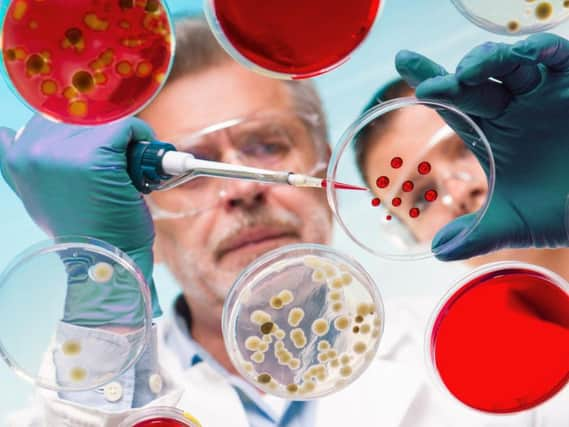Scotland's most miraculous scientific advances


When Dolly the Sheep was born at the Roslin Institute on July 5, 1996, the first mammalian clone created from a single adult somatic cell, she not only marked scientific history, but also the start of an outburst of biotech innovation across Scotland that has drastically changed the scientific landscape worldwide. Academic institutions across the country have instituted research arms in order to capitalise on technological and biochemical advancements while working to combat ailments such as heart disease, cancer, and lung conditions.
‘Life sciences’ is the catch-all phrase to cover these various sectors, all seeking to advance human wellbeing – from drug discovery, to medical devices, to digital and remote health devices, to the generation of healthy, sustainable nutrition for an ever growing global population.
Advertisement
Hide AdAdvertisement
Hide AdCurrently, over 30,000 people are employed in 600 life science organisations across Scotland. These organisations are run by 250 medical tech companies, 150 pharmaceutical firms, and 10 contract research organisations (CROs).
With institutes like the Centre of Regenerative Medicine in Edinburgh, the Stratified Medicine Scotland Innovation Centre in Glasgow, and BioCity in North Lanarkshire, life sciences has positioned itself as a growth sector in Scotland. The Scottish Life Sciences Advisory Board, a government body, is currently in the midst of a 10-year strategy to double the sector’s turnover to £8 billion by 2025. This ambitious goal is being pursued by a strategy that looks to internationalise Scottish life science innovations, ensure production is sustainable, capitalise financially on output, and foster the business partnerships required to fund innovation.
So, it’s big business, and soon to be bigger. But what does this growth industry – one that has already attracted some of the brightest minds from around the globe to these shores, with hopes of attracting more yet, actually do? What are the local life science achievements that stand out?
Drinking like a fish
Scottish salmon are soon going to be fed by proteins extracted from the waste liquid generated by whisky production, thanks to the endeavours of North East biotech firm Horizon Protein.
After conducting two large-scale, highly successful proof-of-concept trials, the firm has proven that it is able to transform ‘pot ale’ – the undrinkable liquid offshoot from whisky distilleries – into raw protein for use as fish food. Having built a production firm in the North East, they’re expecting to generate 12,000 tonnes of protein during 2018, enough to feed 15 per cent of the Scottish salmon population.
It represents a happy symbiosis between two of Scotland’s key industries – whisky and salmon farming – and the hope is that if proven economically viable it will roll out internationally. Utilising pot ale as a source of protein for salmon provides a less expensive, readily-available, locally sourced and sustainable alternative to the current proteins utilised such as fish meal and soya bean meal.
Is there a doctor on your arm?
Despite it being a truism that there’s an app for everything these days, you may have expected that to stop short at there being one to perform the duties of a medical professional. snap40 is an Edinburgh healthcare tech start-up which has developed a device to monitor patients’ vital signs in real time, tracking key indicators like heart rate, blood pressure and temperature. Those patients that are flagged as at risk of deteriorating are referred to clinical staff for immediate attention. It eases the considerable workload of NHS staff by allowing them to prioritise patients in terms of urgency without having to perform a manual triage.
Currently being trialled at NHS Fife and NHS Lothian’s Emergency Medicine Research Group, this ‘doctor on your arm’ transmits raw signals from six different sensors, conducting considerable computation to interpret the vital signs. Each device transmits 15,000 signals every 30 seconds. The trials are due to be completed at the end of 2017 – if successful, the intention is to roll the technology out to six further UK hospitals and one US hospital, with a view to lessening the workload on medical staff as well as saving money.
Growing bones in a lab
Advertisement
Hide AdAdvertisement
Hide AdGrowing human bone in a petri dish seems like the stuff of science fiction, yet recently it proved a reality as Scottish and Irish scientists have developed the ability to grow three-dimensional mineralised bone in a laboratory.
Utilising a technique called ‘nanokicking’ they are now able to subject stem cells to ultra-precise nano-vibrations, as they are held inside a collagen gel. These vibrations morph the cells into a ‘bone putty’ that is then able to heal broken bone fractures and fill gaps in bone. Because this ‘bone putty’ can be mined from the patient’s own cells, it stops the issue of rejection that occurs if a bone graft is supplied by a donor, as well as ensuring a renewable source of bone rather than relying on donors.
Not yet at human trial, the hope is that if this ‘bone putty’ develops to a stage where it is viable to use on people then it will prove invaluable in ensuring land mine victims have enough bone to utilise a prosthesis rather than a wheelchair. It’s already proved effective in veterinary medicine, where the ‘bone putty’ worked as a scaffold to ensure that a dog’s leg could be saved where previously it would have been amputated.
A vision for Life Sciences in Scotland: Accelerating growth, driving innovation is being held by Scotsman Conferences on the 21st of November.
For more information, or to book, visit http://www.scotsmanconferences.com/event/a-vision-for-life-sciences-in-scotland-accelerating-growth-driving-innovation/